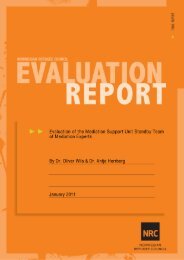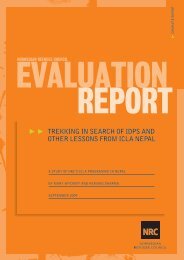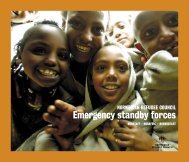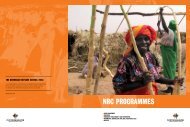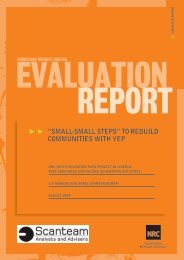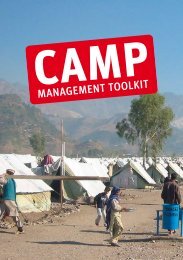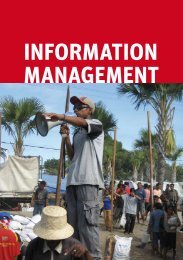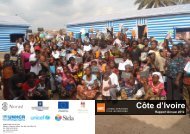evaluation of general food distribution in northern uganda: gulu ...
evaluation of general food distribution in northern uganda: gulu ...
evaluation of general food distribution in northern uganda: gulu ...
Create successful ePaper yourself
Turn your PDF publications into a flip-book with our unique Google optimized e-Paper software.
which <strong>in</strong>clude access to land by IDPs. The rations are expecte d to cover the net <strong>food</strong> gap which the IDPs can notmeet through their own agricultural production.The <strong>food</strong> rations have been ma<strong>in</strong>ta<strong>in</strong>ed s<strong>in</strong>ce January 2006 when the <strong>food</strong> rations were reduced from 74% to60%, 50% and 40% for Non Extremely Vulnerable Indiv iduals (NEVIs) and to 98% for Extremely VulnerableIndividuals (EVIs) <strong>in</strong> Gulu and Amuru districts. For Kitgum district the <strong>food</strong> rations are 60% for NEVIs and 100%for EVIs. The <strong>food</strong> rations normally <strong>in</strong>clude cereals (maize or sorghum), pulses (beans or yell ow split peas) andvegetable oil enriched with Vitam<strong>in</strong> A.The last EFSA <strong>of</strong> April 2007 showed that the <strong>food</strong> security situation has improved slightly but not enough toreduce the <strong>food</strong> ration any further. Up to 70% <strong>of</strong> the households are moderate <strong>food</strong> <strong>in</strong>se cure while around 14%are severely <strong>food</strong> <strong>in</strong>secure, even when <strong>food</strong> aid is <strong>in</strong>cluded. Therefore, there is still a <strong>food</strong> gap <strong>in</strong> most householdsresult<strong>in</strong>g <strong>in</strong> a maximum <strong>of</strong> two meals per day.Project objectivesWith<strong>in</strong> the NRC Distribution core activity there are two project activities, Food Distribution (FFL project) and FoodSecurity and Livelihoods (FSL). While the FFL project provides <strong>food</strong> assistance to IDPs <strong>in</strong> the camps and transitsites on a monthly basis to cover the <strong>food</strong> net gap, the Food Security and Live lihoods provides support to IDPsagricultural production to enable them to susta<strong>in</strong> themselves and assist them <strong>in</strong> the transition phase when theymove to transit sites and eventually their homes <strong>of</strong> orig<strong>in</strong>.The objectives <strong>of</strong> the two project activities are r espectively:Food for Life/FFL:- To contribute to household <strong>food</strong> security and ma<strong>in</strong>ta<strong>in</strong> the m<strong>in</strong>imum nutritional and dietary standard byprovid<strong>in</strong>g <strong>food</strong> assistance to people affected by displacement <strong>in</strong> camps <strong>in</strong> Gulu, Amuru and Kitgumdistricts.- To protect lives by provid<strong>in</strong>g humanitarian <strong>food</strong> assistance to IDPs to meet the assessed average net<strong>food</strong> gap- To safeguard the fundamental right to <strong>food</strong> for targeted IDPs with special emphasis on women andchildren, EVIs, and the long -term effect <strong>of</strong> <strong>in</strong>sufficient a ccess to <strong>food</strong>.Food Security and Livelihoods project:1. To enhance productive capacity and self -reliance <strong>of</strong> displaced households.In this context the Distribution core activity aims at develop<strong>in</strong>g a more comprehensive approach towards <strong>food</strong>security, and contributes to durable solutions for the affected population.B. Purpose and phase for the <strong>evaluation</strong> and <strong>in</strong>tended useNRC’s Food for Life (FFL) project has been operat<strong>in</strong>g <strong>in</strong> Gulu and Kitgum districts s<strong>in</strong>ce 1997 and untildate no <strong>evaluation</strong> has been carried out <strong>of</strong> the program activity. The ma<strong>in</strong> purpose <strong>of</strong> the <strong>evaluation</strong> is toprovide a systematic and objective assessment <strong>of</strong> the achievements and performance <strong>of</strong> the FFL projectover the last three years and identify lessons learned and recommendations fo r future project direction.Emphasis will be placed on evaluat<strong>in</strong>g NRC’s ability to provide assistance <strong>in</strong> a relevant, efficient, effectiveand coord<strong>in</strong>ated manner, as well as coverage and an analysis <strong>of</strong> impact and connectedness.The <strong>in</strong>tended use <strong>of</strong> the eval uation is two-fold:• The results <strong>of</strong> the <strong>evaluation</strong> will be used by the FFL program manager to re -direct, if necessary,the project design and implementation <strong>of</strong> the FFL project.• To consider lessons learned from FFL <strong>in</strong> Uganda <strong>in</strong> design and implementation <strong>of</strong> d istributionprojects <strong>in</strong> similar IDP contexts.C. Scope <strong>of</strong> work and methodEven though the FFL project has been carried out <strong>in</strong> Uganda for more than ten years, s<strong>in</strong>ce 1997, thetimeframe for the <strong>evaluation</strong> will ma<strong>in</strong>ly be limited to the last three years . This co<strong>in</strong>cides with the currentWFP Protracted Relief and Recovery Operation (PRRO) from April 2005 to March 2008. In April 2008 a newPRRO will beg<strong>in</strong>, and the <strong>evaluation</strong> team will assess how the FFL project has been operat<strong>in</strong>g over thelast three years, str engths, weaknesses and lessons learned <strong>of</strong> the project will be evaluated, andrecommendations for the way forward for the follow<strong>in</strong>g PRRO period will be given.The methodology will <strong>in</strong>clude:56





